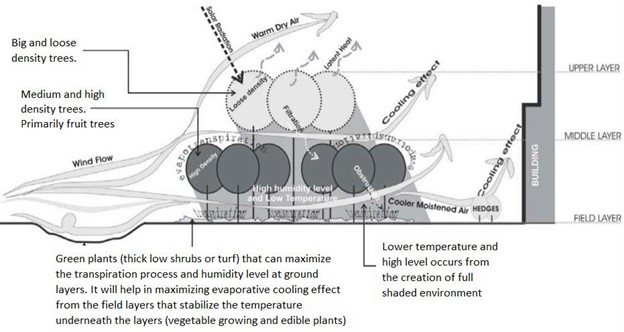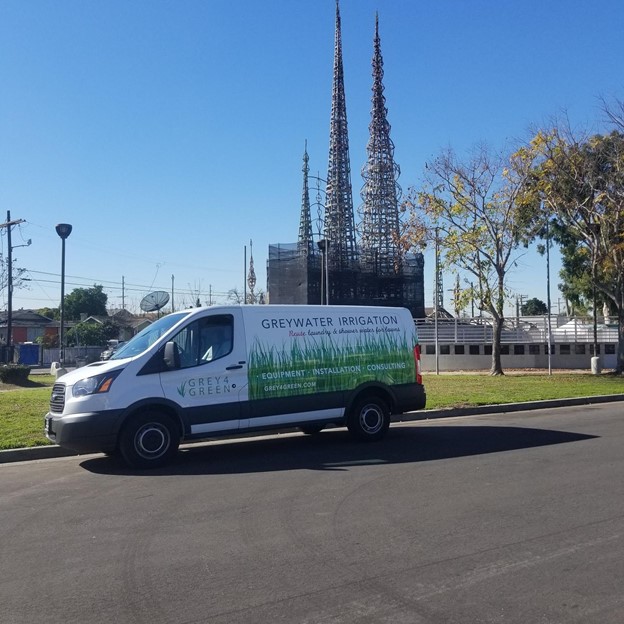by Kathleen Pierce
Many people already have an image of some of the neighborhoods that make up South Central Los Angeles County, California, such as Watts and Compton, from their portrayal in movies and TV. But look beyond the screen and you’ll find a vibrant, forward-thinking community where residents are rolling up their sleeves to make life better for themselves, their children and the planet.
Joseph Gallegos is a serial entrepreneur whose latest project, Grey4Green, focuses on empowering homeowners to use greywater to grow trees and plants to solve urban heat island issues. He was inspired to take additional action when, after reading an article about air pollution, he started to notice black soot on local trees and plants. Studies suggest that some plants act like a filter, removing particulate matter from the air.(1) Gallegos wondered if it could be possible to simultaneously combat air pollution and the region’s notoriously sweltering summers with one low-tech solution: green landscapes.

Graphic from Barwise et. al.
In a project with Thriving Earth Exchange, Gallegos is looking to learn which plants best absorb air pollution, and then encourage residents to turn their yards into living filters to capture it. “Greening up” the region with more plants and trees could cool the overall environment by counteracting urban heat island effects, as well as have many other spillover benefits for residents’ health, nutrition (when fruit trees are grown), energy usage (when trees shade a home) and more.
For the latest in our latest Community Insights series, we sat down with Gallegos to learn more.
What makes air pollution a priority in this community?
Particulate matter 2.5 (PM 2.5) is so small that when we take it up into our lungs, it goes into our bloodstream and our cells, and our body can’t filter it out. It’s a big problem in cities. There’s also a COVID-19 connection. Within these communities, you’ve got front-line workers with lung damage from high particulate matter, and they have higher instances of COVID-19.
We all hear about how bad certain neighborhoods are, and what we need is empowering information to drive solutions and change. Disadvantaged communities may not be able to put solar panels in, but it doesn’t mean that they don’t want to participate in climate mitigation for their kids and themselves.
What solutions and ideas have inspired you?
What inspires me is the desire of this community to be engaged. Sometimes we think that these communities don’t care, or that we have to show them the way, but in reality they are very informed, and want solutions they can implement themselves.
I’m also inspired that our solution can be applied anywhere in the world, because it’s not economically based on disposable income. It’s based on how the community works together on biomimicry (copying nature). Getting people to change for climate good is easy when given the right tools. I try to put an economic value on the project, so I can get more investment and interest from outside stakeholders.
And plants—plants amaze me. Finding these additional uses and benefits is a lost knowledge. Other generations or cultures have known how to use plants, but do we?
How will you match solutions with community priorities?

Image courtesy of Joseph Gallegos
For another project in Los Angeles, to plant trees and water with laundry greywater as a natural way to cool houses in disadvantaged communities, we went door-to-door. We found that the community was really engaged in climate mitigation and wanted to do something, but it had to be something they could afford. So not solar panels or a discount on an electric car—those aren’t motivators. But give them plants, and they’ll do it for the betterment of their kids.
Our plan [for this project] is to go door-to-door in a 6×6-block micro-climate area. When it’s so highly concentrated, you get residual spillover effects that monetize the whole area, even if only 20% of people participate.
What would you advise to others trying to tackle a community issue?
Look for who else benefits from your project, beyond the specific issue you are trying to solve. On a macro level, we are quantifying an air pollution solution, and stakeholders in this area are transportation boards, air quality control boards and other health-related agencies. On the micro-climate scale, trees create shade and save energy, so utility conservation programs are a stakeholder. The trees will be grown with greywater, so the water department’s conservation program is a stakeholder. Some trees are fruit trees, so the health department is a stakeholder. We are even discovering that plant trimmings can be used for biofuels, so there is another stakeholder. By combining all stakeholders together, each dollar invested in the micro-climate program is multiplied.
Also, talk to other people. I was recently on a call with two other Thriving Earth Exchange cohorts—one addressing microplastics in the Bay Area and one working on flooding in Michigan—and we shared ideas for solutions and identifying stakeholders. In addition, I use ResearchGate to find amazing, free research papers on all subjects, and most of the authors are happy to collaborate on grants.
What do you hope your community look like in 20 years?
What we expect in five years is that these micro-level programs will have quantified so many benefits and revenue sources (selling the fruit from the trees, creating local biofuel, etc.) that they will be a community-funded, community-driven model for other intercity suburban neighborhoods.
Longer term, the neighborhood could become more connected and resilient, with people maybe learning how to can fruits and vegetables again, maybe starting small home cooking businesses, teaching themselves urban farming, and making some additional money.
Twenty years from now, we envision this whole area being very green, so green that you can see it from an airplane and think, Is that a park? No, that’s South Central! Just being able to see a giant unstoppable green coverage—I see that as a real motivator.
(1) Barwise, Y., Kumar, P. Designing vegetation barriers for urban air pollution abatement: a practical review for appropriate plant species selection. npj Clim Atmos Sci 3, 12 (2020). https://doi.org/10.1038/s41612-020-0115-3
